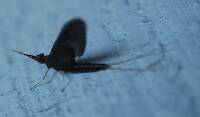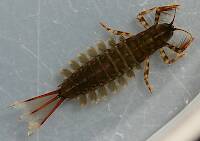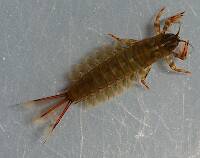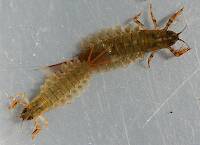
Blue-winged Olives
Baetis
Tiny Baetis mayflies are perhaps the most commonly encountered and imitated by anglers on all American trout streams due to their great abundance, widespread distribution, and trout-friendly emergence habits.
Featured on the forum

This is the first of it's family I've seen, collected from a tiny, fishless stream in the Cascades. The three species of this genus all live in the Northwest and are predators that primarily eat stonefly nymphs Merritt R.W., Cummins, K.W., and Berg, M.B. (2019).

Troutnut is a project started in 2003 by salmonid ecologist Jason "Troutnut" Neuswanger to help anglers and
fly tyers unabashedly embrace the entomological side of the sport. Learn more about Troutnut or
support the project for an enhanced experience here.
Wiflyfisher has attached this picture to aid in identification. The message is below.
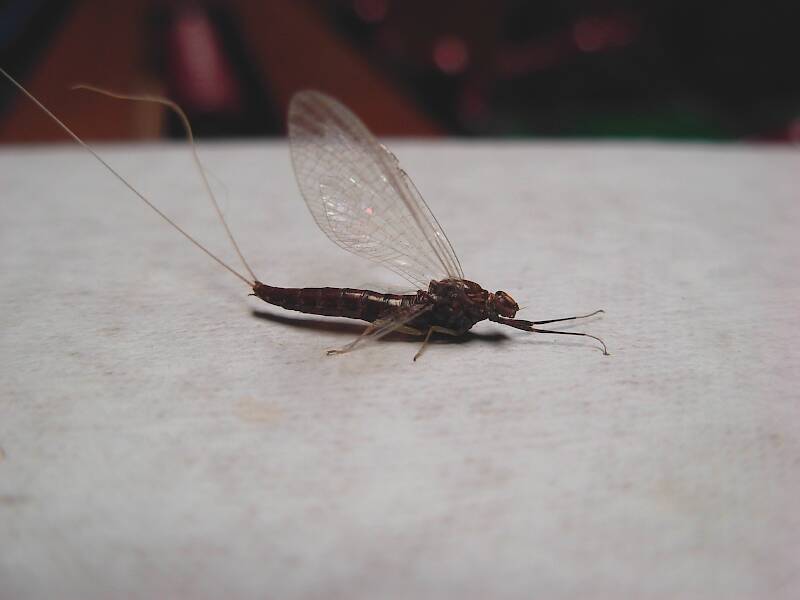
Wiflyfisher on Aug 2, 2007August 2nd, 2007, 5:13 pm EDT
While on the river tonight with lots of caddis I saw a few mayfly spinners that I don't believe I have seen before. It is a dark reddish-brown, and 9/16" long body with 2 tails. It looks a lot like Isonychia bicolor that I have caught before but this is definitely smaller in size. although my guess is it is Isonychia bicolor. See photo for a digital shot I took tonight.
John S.
https://WiFlyFisher.com
https://WiFlyFisher.com
Taxon on Aug 2, 2007August 2nd, 2007, 5:44 pm EDT
John-
I believe it to be an Isonychia bicolor male imago, probably the one previously classified as I. harperi, which has brown forelegs with whitish tarsi. It is listed in The Biology Of Mayflies as having a body length of 12 mm., which is slight less than 9/16".
I believe it to be an Isonychia bicolor male imago, probably the one previously classified as I. harperi, which has brown forelegs with whitish tarsi. It is listed in The Biology Of Mayflies as having a body length of 12 mm., which is slight less than 9/16".
Wiflyfisher on Aug 3, 2007August 3rd, 2007, 2:16 am EDT
Roger, thanks for the reply. I am still surprised because of the size. I realize flies may vary in size. But in the past on this Midwest river the Isonychia bicolor spinners I have collected were a good, solid 1" long and I have never seen them in August. Although I know sparse, sporatic hatches can occur later on for most aquatic insects.
John S.
https://WiFlyFisher.com
https://WiFlyFisher.com
Konchu on Aug 3, 2007August 3rd, 2007, 3:33 am EDT
Isonychia probably is correct, but it could a species other than bicolor. However, bicolor has a lot of variation in its appearance.
Wiflyfisher on Aug 3, 2007August 3rd, 2007, 7:23 am EDT
By the way, what ever happened to Isonychia sadleri? I always thought I. bicolor had the white stripe down the middle of the back of the nymph and I. sadleri did not.
John S.
https://WiFlyFisher.com
https://WiFlyFisher.com
Troutnut on Aug 3, 2007August 3rd, 2007, 7:43 am EDT
I. bicolor has a wide spectrum of stripey-ness (to use the technical term) in the nymph. I even found one that kept the stripe as a dun in Penn's Creek.
This one is surely Isonychia, and probably it's just a small bicolor. (I would say "definitely," but Konchu's "probably correct" phrasing leads me to think there's some very obscure and improbable family he can't quite rule out. Or maybe he's just displaying a scientist's habitual caution.)
I've caught I. bicolor duns in a variety of sizes. This might be the first one I've seen that's actually as small as all the imitations sold in fly shops.
This one is surely Isonychia, and probably it's just a small bicolor. (I would say "definitely," but Konchu's "probably correct" phrasing leads me to think there's some very obscure and improbable family he can't quite rule out. Or maybe he's just displaying a scientist's habitual caution.)
I've caught I. bicolor duns in a variety of sizes. This might be the first one I've seen that's actually as small as all the imitations sold in fly shops.
Jason Neuswanger, Ph.D.
Troutnut and salmonid ecologist
Troutnut and salmonid ecologist
Wiflyfisher on Aug 3, 2007August 3rd, 2007, 9:20 am EDT
Jason, you can guess which river I caught it on, probably the same river you photographed yours on too. Just amazes me that it's such a smaller size. Maybe I discovered a NEW sub-species!! We could call it: Isonychia bicolor runta, or Isonychia bicolor namie. :)
John S.
https://WiFlyFisher.com
https://WiFlyFisher.com
Taxon on Aug 3, 2007August 3rd, 2007, 10:11 am EDT
By the way, what ever happened to Isonychia sadleri?
John-
It became one of the many synonyms of Isonychia bicolor. See below, which is cut and pasted (and in my opinion, properly italicized) from Mayfly Central's N. American Master Species List:
Isonychia bicolor (Walker), 1853 [CAN:NE;USA:NE,SE]
- Chirotonetes albomanicatus Needham, 1905 (syn.)
Isonychia albomanicata (Needham), 1905 (syn.)
Isonychia christina Traver, 1934 (syn.)
Isonychia circe Traver, 1934 (syn.)
Isonychia fattigi Traver, 1934 (syn.)
Isonychia harperi Traver, 1934 (syn.)
Isonychia matilda Traver, 1934 (syn.)
Isonychia pacoleta Traver, 1932 (syn.)
Isonychia sadleri Traver, 1934 (syn.)
Palingenia bicolor Walker, 1853 (orig.)
Siphlurus bicolor (Walker), 1853 (comb.)
Wiflyfisher on Aug 3, 2007August 3rd, 2007, 10:50 am EDT
Roger, thanks. I saw that earlier today when I did a Google search. I am curious to know how they determine all those species are all the same insect?
John S.
https://WiFlyFisher.com
https://WiFlyFisher.com
Taxon on Aug 3, 2007August 3rd, 2007, 11:50 am EDT
John-
I could probably provide an answer that is adequate for your purposes, but I'm hoping Konchu will step to the plate, and give you something better.
I could probably provide an answer that is adequate for your purposes, but I'm hoping Konchu will step to the plate, and give you something better.
Konchu on Aug 3, 2007August 3rd, 2007, 12:41 pm EDT
Boris Kondratieff worked on this group in the 1980s. He reported his findings, with coauthor JR Voshell, in the following paper:
Kondratieff BC; Voshell JR Jr. 1984. The North and Central American species of Isonychia (Ephemeroptera: Oligoneuriidae). Transactions of the American Entomological Society 110:129-244.
You'd have to locate a copy at a university that carries that journal.
The old-fashioned way to determine that all the species are the same insect (and still the way most people do it now) is to look at lots and lots of specimens from as many different places and from as many different times as possible. Spinners, duns, nymphs, eggs. The works. Raise the larvae through to the adult stage to see what you get. Compare what you see to museum specimens (especially those that are the 'official' holders of names). Even better yet: get out in the streams and observe who lives where and how each form acts. In other words, try your darndest to find differences. New molecular tools can help sort things out (or murky the water), but often the old, name-bearing, specimens cannot be defaced or destroyed to take tissue necessary for molecular analysis. So you're left with the expert's *opinion*, based on what he or she has seen.
Gotta run. Happy Friday, everyone!
Kondratieff BC; Voshell JR Jr. 1984. The North and Central American species of Isonychia (Ephemeroptera: Oligoneuriidae). Transactions of the American Entomological Society 110:129-244.
You'd have to locate a copy at a university that carries that journal.
The old-fashioned way to determine that all the species are the same insect (and still the way most people do it now) is to look at lots and lots of specimens from as many different places and from as many different times as possible. Spinners, duns, nymphs, eggs. The works. Raise the larvae through to the adult stage to see what you get. Compare what you see to museum specimens (especially those that are the 'official' holders of names). Even better yet: get out in the streams and observe who lives where and how each form acts. In other words, try your darndest to find differences. New molecular tools can help sort things out (or murky the water), but often the old, name-bearing, specimens cannot be defaced or destroyed to take tissue necessary for molecular analysis. So you're left with the expert's *opinion*, based on what he or she has seen.
Gotta run. Happy Friday, everyone!
Wiflyfisher on Aug 4, 2007August 4th, 2007, 1:13 am EDT
Konchu, thank you for elaborating on how you go about trying to determine the various types of aquatic insects. Now for my next question. :-)
When does variation in appearance dictate that the insect is another specie in the same family/genus rather than calling it the same specie as others?
However, bicolor has a lot of variation in its appearance
When does variation in appearance dictate that the insect is another specie in the same family/genus rather than calling it the same specie as others?
John S.
https://WiFlyFisher.com
https://WiFlyFisher.com
Konchu on Aug 4, 2007August 4th, 2007, 1:53 am EDT
As with the organisms themselves, this answer can vary.
Long story short, though: if there is not a smooth range of variation and some forms are consistently distinctive in at least one life stage, then perhaps these represent a new species. Sometimes different species are not that different in form, but have big differences in behavior (e.g., some crickets' songs, fireflies' flash pattern, perhaps some aquatic insects' courtship behavior). DNA differences can make strong suggestions about this, too, and the DNA is really useful because it doesn't change between life stages (egg, larva... adult). But we still need to develop our DNA technology further.
Long story short, though: if there is not a smooth range of variation and some forms are consistently distinctive in at least one life stage, then perhaps these represent a new species. Sometimes different species are not that different in form, but have big differences in behavior (e.g., some crickets' songs, fireflies' flash pattern, perhaps some aquatic insects' courtship behavior). DNA differences can make strong suggestions about this, too, and the DNA is really useful because it doesn't change between life stages (egg, larva... adult). But we still need to develop our DNA technology further.
Millcreek on Jul 25, 2014July 25th, 2014, 7:22 am EDT
John -
You can find this paper, if you haven't already, at this web address:
http://www.ephemeroptera-galactica.com/pubs/pub_k/pubkondratieffb1984p129.pdf
Kondratieff BC; Voshell JR Jr. 1984. The North and Central American species of Isonychia (Ephemeroptera: Oligoneuriidae). Transactions of the American Entomological Society 110:129-244.
You can find this paper, if you haven't already, at this web address:
http://www.ephemeroptera-galactica.com/pubs/pub_k/pubkondratieffb1984p129.pdf
"If we knew what it was we were doing, it would not be called research, would it?"
-Albert Einstein
-Albert Einstein
Quick Reply
Related Discussions
Topic
Replies
Last Reply
0
Jul 3, 2006
by Troutnut
by Troutnut
4
Apr 17, 2009
by GONZO
by GONZO







